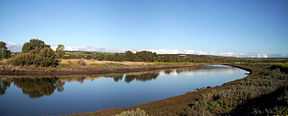Onkaparinga River
| Onkaparinga River | |
|---|---|
 Onkaparinga Estuary | |
| Origin | Between Charleston and Mount Torrens |
| Mouth | Port Noarlunga |
| Length | 95 km |
| Source elevation | 650 m |
| Basin area | 562 km² |
The Onkaparinga River runs from its source between Mount Torrens and Charleston in the Mount Lofty Ranges, and flows south westerly to an estuary at Port Noarlunga. The catchment is over 500 km² in area, and is in part located in the Onkaparinga River National Park.
The Onkaparinga River is the second major river of the Adelaide region, after the River Torrens. The name derives from the Indigenous Kaurna name Ngangiparri which translates as "The Women's River".
In 1837 Surveyor General Col William Light named it Field's River, or the Field River, after Lieut William George Field RN (1804-1850) of the brig Rapid, who carried out the first surveys in the vicinity of its estuary, but subsequent Governor George Gawler soon reinstated the Indigenous name. The first Europeans to explore its sources and the Onkaparinga Valley were the party of Dr. George Imlay and John Hill in January 1838.[1]
It is a source of fresh water for the city of Adelaide. Mount Bold Reservoir was constructed between 1932 and 1938 along a section of its path approximately 20km inland. Much of its flow is diverted via a tunnel from the Clarendon Weir to the Happy Valley Reservoir, that in turn supplies some 40 per cent of Adelaide's water supply. Most years the flow to the reservoir is supplemented by water pumped from the River Murray via a pipeline from Murray Bridge.
Downstream from Mount Bold Reservoir is the Clarendon Weir. To maintain levels at Clarendon Weir, water is released only as required. The Onkaparinga Gorge extends from Clarendon to Old Noarlunga. An estuary extends from Old Noarlunga to the river's mouth at Port Noarlunga. The estuary is a significant breeding area for local marine fish species.

The Coast to Vines rail trail crosses over the river just west of where Main South Road crosses over.
External links
References
- ↑ The Colonist, 7 March 1838, p. 2.
Coordinates: 35°10′S 138°28′E / 35.167°S 138.467°E